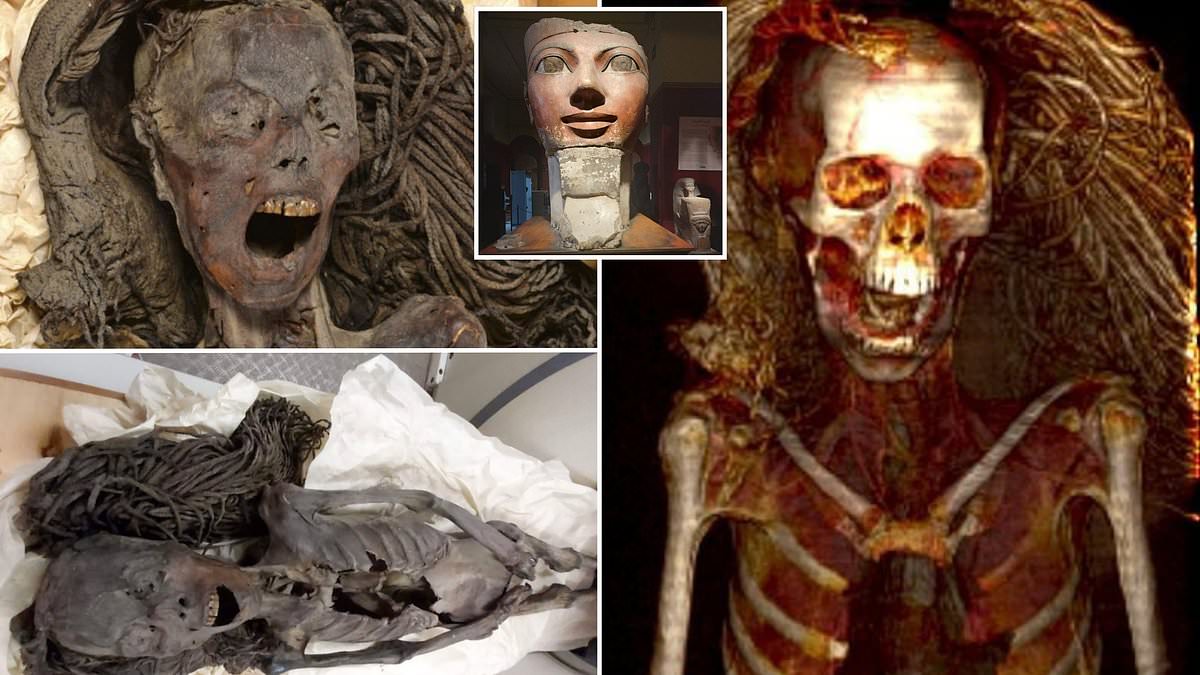When it comes to death, most of us would hope for a peaceful and pain-free passing.
So spare a thought for this Egyptian mummy, who likely died screaming in agony 3,500 years ago, according to researchers.
The mummy was first discovered in 1935, when an archaeological expedition unearthed a wooden coffin located beneath the tomb of the architect Senmut, who died in 1464BCE.
The coffin held the mummified body of an unidentified woman wearing a black wig and two scarab rings in silver and gold – but what struck archaeologists the most was her expression.
With the mouth wide open, as if locked in a wail, they dubbed her the ‘Screaming Woman’.

When it comes to death, most of us would hope for a peaceful and pain-free passing. So spare a thought for this Egyptian mummy, who likely died screaming in agony 3,500 years ago, according to researchers

The mummy was first discovered in 1935, when an archaeological expedition unearthed a wooden coffin located beneath the tomb of the architect Senmut, who died in 1464BCE
Read More
CT scans reveal 'the mummy of the screaming woman' died of a massive heart attack 3,000 years ago and developed a death spam before being embalmed

Now, researchers have used the most advanced scientific techniques to examine the mummy and learn about her life and death.
Advanced scanning techniques revealed the woman was lying facing upwards with her legs extended and her hands folded above the groin.
She lacked several teeth – likely lost before death – and she would have been about 1.54 metres tall in life.
CT images estimated that she was approximately 48 years old at the time of her death and had suffered from mild arthritis of the spine.
Analysis revealed that the Screaming Woman had been embalmed with juniper and frankincense – costly materials that had to be imported into Egypt.


CT images estimated that she was approximately 48 years old at the time of her death and had suffered from mild arthritis of the spine

Archaeologists excavated the tomb of Senmut, the architect and overseer of royal works – and reputedly, lover – of the famed queen Hatschepsut (statue pictured). Beneath Senmut’s tomb, they found a separate burial chamber for his mother Hat-Nufer and other, unidentified relatives – including the Screaming Woman
Read More
Meet the 'gilded lady': Scientists reconstruct face of mysterious mummy known for 'golden headdress'

The rarity and cost of embalming materials seems to rule out that the mummification process had been careless and that the embalmers had simply neglected to close her mouth, the researchers said.
Dr Sahar Saleem, one of the study’s authors from Cairo University, said: ‘The mummy’s screaming facial expression in this study could be read as a cadaveric spasm, implying that the woman died screaming from agony or pain.’
Cadaveric spasm is a rare form of muscular stiffening, typically associated with violent deaths under extreme physical conditions and intense emotion.
‘The Screaming Woman is a true time capsule of the way that she died and was mummified,’ Dr Saleem added.
The findings, published in the journal Frontiers in Medicine, also show there was no obvious cause of death.
The mummy was also discovered with her brain, diaphragm, heart, lungs, liver, spleen, kidneys and intestine still present.
This was a surprise, was the classic method of mummification in the New Kingdom – between 1550 and 1069 BCE – included the removal of all such organs except the heart.

The mummy was discovered with her brain, diaphragm, heart, lungs, liver, spleen, kidneys and intestine still present
